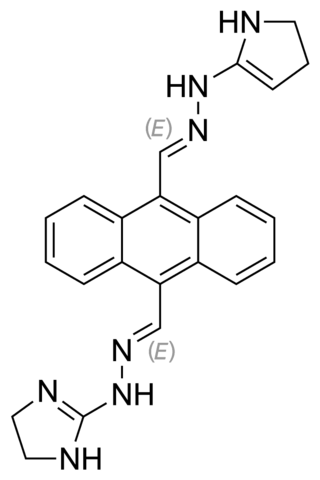
Chemotherapy is the type of cancer treatment that uses one or more anti-cancer drugs in a standard regimen. Chemotherapy may be given with a curative intent, or it may aim only to prolong life or to reduce symptoms. Chemotherapy is one of the major categories of the medical discipline specifically devoted to pharmacotherapy for cancer, which is called medical oncology.
Transcatheter arterial chemoembolization (TACE) is a minimally invasive procedure performed in interventional radiology to restrict a tumor's blood supply. Small embolic particles coated with chemotherapeutic drugs are injected selectively through a catheter into an artery directly supplying the tumor. These particles both block the blood supply and induce cytotoxicity, attacking the tumor in several ways.

Doxorubicin, sold under the brand name Adriamycin among others, is a chemotherapy medication used to treat cancer. This includes breast cancer, bladder cancer, Kaposi's sarcoma, lymphoma, and acute lymphocytic leukemia. It is often used together with other chemotherapy agents. Doxorubicin is given by injection into a vein.

Daunorubicin, also known as daunomycin, is a chemotherapy medication used to treat cancer. Specifically it is used for acute myeloid leukemia (AML), acute lymphoblastic leukemia (ALL), chronic myelogenous leukemia (CML), and Kaposi's sarcoma. It is administered by injection into a vein. A liposomal formulation known as liposomal daunorubicin also exists.

Anthracyclines are a class of drugs used in cancer chemotherapy that are extracted from Streptomyces peucetius bacterium. These compounds are used to treat many cancers, including leukemias, lymphomas, breast, stomach, uterine, ovarian, bladder cancer, and lung cancers. The first anthracycline discovered was daunorubicin, which is produced naturally by Streptomyces peucetius, a species of Actinomycetota. Clinically the most important anthracyclines are doxorubicin, daunorubicin, epirubicin and idarubicin.

Epirubicin is an anthracycline drug used for chemotherapy. It can be used in combination with other medications to treat breast cancer in patients who have had surgery to remove the tumor. It is marketed by Pfizer under the trade name Ellence in the US and Pharmorubicin or Epirubicin Ebewe elsewhere.

Sunitinib, sold under the brand name Sutent, is an anti-cancer medication. It is a small-molecule, multi-targeted receptor tyrosine kinase (RTK) inhibitor that was approved by the FDA for the treatment of renal cell carcinoma (RCC) and imatinib-resistant gastrointestinal stromal tumor (GIST) in January 2006. Sunitinib was the first cancer drug simultaneously approved for two different indications.

Lapatinib (INN), used in the form of lapatinib ditosylate (USAN) is an orally active drug for breast cancer and other solid tumours. It is a dual tyrosine kinase inhibitor which interrupts the HER2/neu and epidermal growth factor receptor (EGFR) pathways. It is used in combination therapy for HER2-positive breast cancer. It is used for the treatment of patients with advanced or metastatic breast cancer whose tumors overexpress HER2 (ErbB2).

Dexrazoxane hydrochloride, sold under the brand name Zinecard among others, is a cardioprotective agent. It was discovered in 1972. The IV administration of dexrazoxane is in acidic condition with HCl adjusting the pH.

Cediranib is a potent inhibitor of vascular endothelial growth factor (VEGF) receptor tyrosine kinases.

Breast cancer chemotherapy refers to the use of cytotoxic drugs (chemotherapy) in the treatment of breast cancer.

Ixabepilone is a pharmaceutical drug developed by Bristol-Myers Squibb as a chemotherapeutic medication for cancer.

Pixantrone is an experimental antineoplastic (anti-cancer) drug, an analogue of mitoxantrone with fewer toxic effects on cardiac tissue. It acts as a topoisomerase II poison and intercalating agent. The code name BBR 2778 refers to pixantrone dimaleate, the actual substance commonly used in clinical trials.
Magnetic-targeted carriers, also known as MTCs or magnetic vehicles, are micro- or nanoparticles that carry an anticancer drug to the target site by using an external magnetic field and field gradient to direct the desired drug. Usually, the complex involves microscopic beads of activated carbon, which bind the anticancer drug. A magnet applied from outside the body then can direct the drug to the tumor site. This can keep a larger dose of the drug at the tumor site for a longer period of time, and help protect healthy tissue from the side effects of chemotherapy.

Evofosfamide is a compound being evaluated in clinical trials for the treatment of multiple tumor types as a monotherapy and in combination with chemotherapeutic agents and other targeted cancer drugs.

Galena Biopharma, Inc. was a publicly traded pharmaceutical company based in San Ramon, California. The company was founded in Worcester, Massachusetts. In 2011, it moved to Oregon, and in 2015 moved to San Ramon, California. Mark Schwartz was the company's president and chief executive officer. As of December 29, 2017, the company was acquired by Sellas Life Sciences Group Ltd. through a reverse merger transaction. Galena Biopharma was renamed to Sellas Life Sciences Group, Inc..

N-(2-Hydroxypropyl)methacrylamide or N-HPMA is the monomer used to make the polymer poly(N-(2-hydroxypropyl)methacrylamide).

Aldoxorubicin (INNO-206) is a tumor-targeted doxorubicin conjugate in development by CytRx. Specifically, it is the (6-maleimidocaproyl) hydrazone of doxorubicin. Essentially, this chemical name describes doxorubicin attached to an acid-sensitive linker.

Mirvetuximab soravtansine, sold under the brand name Elahere, is a medication used as a treatment for epithelial ovarian cancer, fallopian tube cancer, or primary peritoneal cancer. Mirvetuximab soravtansine is a folate receptor alpha directed antibody and microtubule inhibitor conjugate.

Bisantrene is an anthracenyl bishydrazone with anthracycline-like antineoplastic activity and an antimetabolite. Bisantrene intercalates with and disrupts the configuration of DNA, resulting in DNA single-strand breaks, DNA-protein crosslinking, and inhibition of DNA replication. This agent is similar to doxorubicin in chemotherapeutic activity, but unlike anthracyclines like doxorubicin, it exhibits little cardiotoxicity.
















